THREE hours at Ballyhane Stud is like a crash course in the thoroughbred industry. Joe Foley has an involvement in so many threads that his informed opinion is always worth documenting and taking on board.
Stallion man, breeder with 50 broodmares, pinhooker, racing manager for Clipper Logistics, purchaser of Clipper boss Steve Parkin’s yearlings and providing the pre-training for the next crop of juveniles that includes Parkin’s growing band of homebreds.
Foley has the good sense to place the latter responsibility in the hands of his wife Jane, who has a trainer’s licence and as the daughter of Sunnyhill Stud boss Michael Hickey, has been around horses all her life. Indeed she runs the operation while he gets on with his juggling act.
That includes his advocacy on behalf of breeders and racing, via his roles as president (and former chairman) of the Irish Thoroughbred Breeders’ Association and vice-chairman of the Irish European Breeders’ Fund. He was also the man who got the ball rolling on Irish Champions Weekend.
Driving out of Leighlinbridge, just on the Carlow side of the border with Kilkenny, you’re grinning, thinking you’d love this life. If only you had a clue and the neck.
Foley regularly refers to “the buzz” he gets, usually with wide, lit-up eyes. The enthusiasm hasn’t waned from the moment his late father PJ – now remembered by virtue of a Ballyhane Stud-sponsored bumper at Gowran Park – decided to try his hand at breeding.
PJ was a cattle farmer and racing didn’t register. Unlike nowadays, when the local Centra is lined at lunchtime with people in jodhpurs queueing at the deli, Paddy Mullins was the only trainer around. There were no breeders. But PJ took a notion that it might be fun to own a racehorse so he bought a mare for £600 that went on to win “a heap of races” under Mullins’s astute stewardship. As often happens, the bug took hold, and when the mare retired, PJ decided to breed.
But if the bug took a bite of PJ, it made Joe its host. He was fascinated by the task of selecting the right stallion. When he should have been swotting for exams, he was consuming pedigrees. He made sense of the maze of family trees and it enthralled him.
That adolescent eagerness hasn’t dissipated one iota. It doesn’t matter if it’s Dandy Man, Morning Assembly, who Jane is going to try in Racehorse to Riding Horse if his single-mindedness allows it, Soldiers Call, Suedois, the “lovely” Havana Gold filly we watch doing some work on the round sand gallop, Castlegrace Paddy and Dunvegan’s intended participation at Leopardstown today or last week’s ITBA awards. He is almost aflame with passion.
Buzzing.
EXPANSION
There is no trace of the cattle farm at Ballyhane Stud now. There are other animals, mind you. Patch is one of six dogs, a Collie that resorts to that hilarious high-speed circular motion of euphoric anticipation as we drive down to the gallops, frustrated that we are not moving quickly enough as the driver points to expectant mares and promising progeny.
“They are all machines at this time of the year” he says, smiling.
On the way we pass Pig. All the naming energy clearly goes into the horses. The two-year-old porker is ambling around and has free rein because he gets on with the equine residents. It is the most welcoming, happy environment. Combined with the expertise and fervour that lies within, it comes as no surprise that Ballyhane Stud is a market leader.
Joe began dabbling in pinhooking foals back in the 1980s. After five 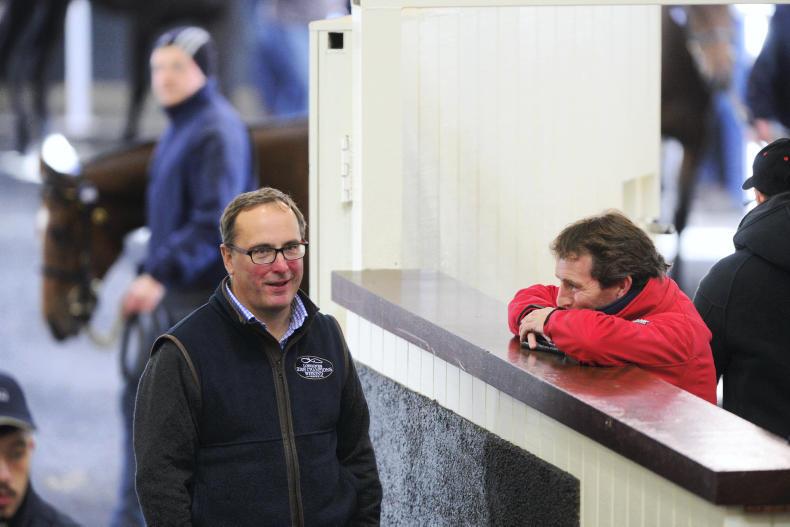
JOE FOLEY and NORMAN WILLIAMSON. Photo HEALY RACING.
years at Coolmore, he had sufficient know-how and collateral to go out on his own. PJ was more than happy to give him his head.
“As it kept growing, we’d nab another cattle barn off him and convert it into a horse barn. I kept encroaching in on top of it but as he was moving towards retirement, the timing was good. But he loved horses and racing.”
The harsh economic climate actually proved helpful in establishing the stud as a stallion farm.
“It was a bad time but it was also a good time. It was in the middle of a really bleak recession. I bought a horse called River Falls and I was able to buy him cheaply because of the recession. Because of that, I was able to stand him cheaply. Breeders were looking for good value – it was about £1,250. He was a very good-looking horse. He got lovely foals that made lots of money, averaging over 10 times the stud fee. So that helped set me off.”
Dandy Man is the head of the pack nowadays, while Elzaam is the potential successor that still represents potential value and has been well supported. Like a soccer manager, he is always scouting for the next big thing, but it is more difficult now.
“A lot of the big race horses are in the hands of end-users from a stallion point of view. Back then, Sheikh Mohammed didn’t have a stallion operation. All those horses were for sale. But now, all the top guys have stallion farms so those horses are off-limits. So you’ve to try pick and choose the ones in the middle of those and there’s not too many.”
Determining what will make a good stallion is a “complex” operation.
“First of all, you gotta work out whether he’s going to be popular enough that breeders are going to send mares to him because without the mares he’s not going to make it. That means he’s gotta have a popular pedigree, be good looking and so will get good-looking foals. He has to be a good enough racehorse to attract people as well. There is that balance. That is only to get people to send mares to him.
“Then you have got to buy him at the right cost that financially it makes sense. And that you can stand at a fee that people can make money out of him as well. All of that, and that is only number one, that is before you go anywhere near trying to work out whether he can actually be a good stallion or not, which is at the end of the day is the most important thing. To do that to me he has got to be as good a racehorse as you can find. There is no surprise Kingman was brilliant first season last year because he was a brilliant racehorse.
“However, pedigree is important too. You have got to get a sire line that works but importantly for me a dam line that works. Physically he has got to be able to get physical horses that look that they can run. Very important, a thing that gets forgotten, he has got to get the proper temperament.”
Piece of cake.
PLENTY OF CHANGES
Fresh from the ITBA awards last Saturday night, which he was heavily involved in organising, he was emboldened by the many human stories that emerged. But there are plenty challenges.
“The biggest situation is the lack of prize money in Britain. And unfortunately for us, we are in more of an exporting market than a self-sufficient market. HRI are well aware of the importance of the prize money. They do their best to have the prize money as high as they can get it, admirably so.
“But unfortunately because we are an export market we are depending on the British market to be buoyant. The British market is not as buoyant as it should be. For me it’s because of the diminishing levels of prize money. It’s the elephant in the room.
“I have seen the debate in Britain recently about staff. A lot of them missed the big point, it all goes back to prize money. The prize money is more, the owner gets more, the trainer can charge more, pay the staff more, give them more time off. If they doubled the prize money in Britain the trainers can pay their staff.”
The situation in Ireland is helped considerably by the EBF, the biggest single sponsor of races in Ireland. Their partnership with Foran Equine 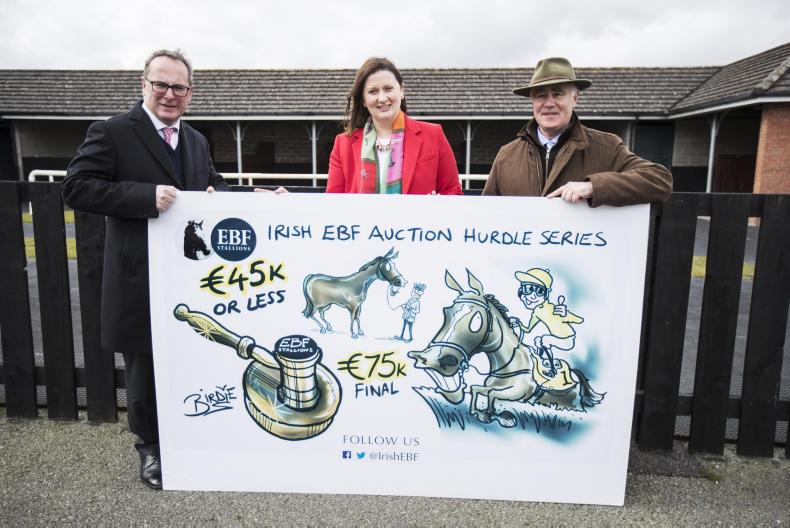
Joe Foley, Nessa Joyce and John O'Connor launch the Irish EBF Auction Hurdle series.Photo: Patrick McCann 01.04.2018
for the auction series on the flat, and Connolly’s Red Mills for its maiden hurdle equivalent, has been hugely successful.
“The European Breeders Fund has a responsibility to its governance and its payers, which are the stallion people. They want a stimulated market and that is what we are trying to do. We are also helping the trainers, challenging them to get syndicates to buy horses.
“The filly who won the final last year, the Dandy Man filly Cedars Of Lebanon, she cost €12,000. Owned by a syndicate. She won a €72,000 first prize when she won the final (and has since been sold to America). Now we are trying to do it in the National Hunt with the help of Red Mills.
GROW AND GROW
We will obviously have a look at it and review it but that looks like a scheme that we can grow and grow. We have plans to put a similar bumper scheme in place. We met HRI last week and they are positive towards that idea.
“Having reviewed the market last year, we have got some serious plans for the flat as well into 2020. We are going to work on a package of things that will hopefully stimulate that commercial end of the market. We are going to try and launch that next summer well before the sales so that everyone knows what is on offer from the Irish flat scene, where they can avoid the Galileo and the Dubawi, give them a good proper chance.
“That challenges the trainers to step up and buy one for €10,000. They have a chance of winning without taking on the superpowers. But they have to go out and buy one. It is not going to be handed to them. What we are going to try and do in conjunction with HRI is provide them with the playground but they have to go out and play.”
GOVERNMENT SUPPORT
He acknowledges government support for racing but the abolition of the tax exemption for stallion operators in 2008, when he was ITBA chairman, is still raw. It has not produced the revenue the politicians expected and he argues that it has contributed to Ireland no longer being the premier stallion base.
“It would be nice if people like Minister for Justice Charlie Flanagan, who attended the ITBA Awards, and Minister Creed just took a look at our industry. Maybe it does need some help. We are big rural players. The broodmare band needs to be upped in Ireland… The breeders are just breeding off the same old mares, the mares are getting older.
They are not getting the finances to allow them to reinvest in a new mare. It goes back to the market being weak. If there was some stimulant there that would allow them, be it a capital stock relief or something. People in America get tax relief for buying yearlings.”
Generally though, Foley is not one for negativity and much like his own plunge into the business, sees opportunities.
“Last year was a perfect storm negative-wise. It all manifested itself back into the foals’ sales and the foals’ sales were very poor. There were essentially pinhookers buying foals, extremely professional people who just selected what they wanted and anything that was outside their selection process was sadly unwanted.
“The foal sale market though is a microcosm of the big market which is the yearling market. People shouldn’t be too downbeat. The yearling market was much stronger than the foal market. The yearling market next August will be much stronger again, especially if we can put the Brexit thing to bed in some fashion. That is causing so much uncertainty.
“The game goes through cycles and we have all been here before where it was all doom and gloom and nobody wants to cover or buy a mare. It’s been proven over the years that that is the actual time to do it.
“When everybody is going one way you should go the other way.”
IRISH CHAMPIONS WEEKEND
As the man who first planted the seed of Irish Champions Weekend, he is satisfied with its development to date and predicts that the new Curragh will bring about further progress.
He would like to see more British visitors and suggests we are not far from having a runner from America or Japan, but the racing stands up as it is.
Additionally, fears that it would become a Coolmore benefit have proven wide of the mark, and the almost Cheltenham-style celebrations following many of the races involving lower-profile trainers, syndicates and other smaller owners have become a feature of the weekend. 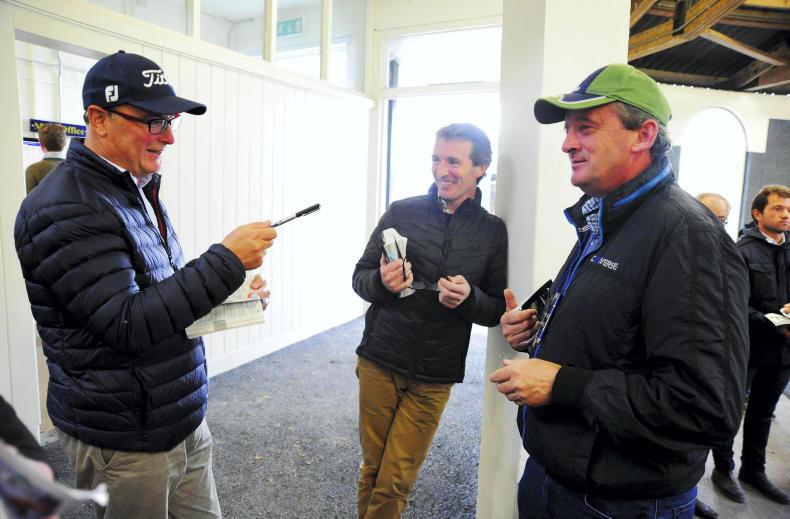
Joe Foley, Norman Williamson and Eddie O'Leary at Tattersalls Ireland September Yearling Sale. Photo HEALY RACING.
Being part of those ranks when Suedois won back his owner’s cash in the Clipper Logistics Boomerang Stakes is a personal highlight. It should be the focus of racing’s marketing he maintains, rather than the more ephemeral accessories.
“We need more of that in the flat because that is what National Hunt has, the common man appeal. You don’t get much fun going to a winner’s enclosure if there is a ripple of applause. You need to get the adrenaline and emotion flowing. We are providing that on Irish Champions Weekend. You would like to see more of that.
“I don’t work in a marketing department in HRI when I go to Leopardstown and the Curragh, whatever amount of people are there, I like to talk to my mates going home saying ‘That was a great day’s racing.’
Whatever number comes I want them to be entertained. There is no point in having 20,000 people there if 6,000 are waiting for a band to come on after. That is not going to grow racing.
“The Dublin Racing Festival was born out of Irish Champions Weekend, it’s the same thing. Look at the success of that after one year. That is just going to grow and grow. That is going to rival Cheltenham in a number of years.”
MULTI-FACETED
He tells a story that sums up his multi-faceted involvement in the industry.
“River Boyne is a leading horse in America by Dandy Man. I was watching him run in a Grade 1 in December from a bar in Newmarket during the foal sales but you couldn’t hear the commentary. I just knew him by the colours. He got chinned on the line. Then someone said to me the winner was Raging Bull and I went ‘ohhh’.
“I had seen Raging Bull as a yearling and I loved him. Because I loved him, I bought his foal half-sister by Pivotal for Steve. She is here, a lovely three-year-old filly called Rapture. She is a half-sister to Raging Bull who beat my Dandy Man. Isn’t that hilarious?”
Little wonder he has admiration for the leading point-to-point producers, and those that habitually flourish at the breeze-ups. He likes to see entrepreneurial spirit rewarded.
“I had the dream of standing stallions and having mares and buying horses and buying racehorses and managing racehorses. No tradition, zero. And no knowledge.”
Look at him now. Buzzing.
THREE hours at Ballyhane Stud is like a crash course in the thoroughbred industry. Joe Foley has an involvement in so many threads that his informed opinion is always worth documenting and taking on board.
Stallion man, breeder with 50 broodmares, pinhooker, racing manager for Clipper Logistics, purchaser of Clipper boss Steve Parkin’s yearlings and providing the pre-training for the next crop of juveniles that includes Parkin’s growing band of homebreds.
Foley has the good sense to place the latter responsibility in the hands of his wife Jane, who has a trainer’s licence and as the daughter of Sunnyhill Stud boss Michael Hickey, has been around horses all her life. Indeed she runs the operation while he gets on with his juggling act.
That includes his advocacy on behalf of breeders and racing, via his roles as president (and former chairman) of the Irish Thoroughbred Breeders’ Association and vice-chairman of the Irish European Breeders’ Fund. He was also the man who got the ball rolling on Irish Champions Weekend.
Driving out of Leighlinbridge, just on the Carlow side of the border with Kilkenny, you’re grinning, thinking you’d love this life. If only you had a clue and the neck.
Foley regularly refers to “the buzz” he gets, usually with wide, lit-up eyes. The enthusiasm hasn’t waned from the moment his late father PJ – now remembered by virtue of a Ballyhane Stud-sponsored bumper at Gowran Park – decided to try his hand at breeding.
PJ was a cattle farmer and racing didn’t register. Unlike nowadays, when the local Centra is lined at lunchtime with people in jodhpurs queueing at the deli, Paddy Mullins was the only trainer around. There were no breeders. But PJ took a notion that it might be fun to own a racehorse so he bought a mare for £600 that went on to win “a heap of races” under Mullins’s astute stewardship. As often happens, the bug took hold, and when the mare retired, PJ decided to breed.
But if the bug took a bite of PJ, it made Joe its host. He was fascinated by the task of selecting the right stallion. When he should have been swotting for exams, he was consuming pedigrees. He made sense of the maze of family trees and it enthralled him.
That adolescent eagerness hasn’t dissipated one iota. It doesn’t matter if it’s Dandy Man, Morning Assembly, who Jane is going to try in Racehorse to Riding Horse if his single-mindedness allows it, Soldiers Call, Suedois, the “lovely” Havana Gold filly we watch doing some work on the round sand gallop, Castlegrace Paddy and Dunvegan’s intended participation at Leopardstown today or last week’s ITBA awards. He is almost aflame with passion.
Buzzing.
EXPANSION
There is no trace of the cattle farm at Ballyhane Stud now. There are other animals, mind you. Patch is one of six dogs, a Collie that resorts to that hilarious high-speed circular motion of euphoric anticipation as we drive down to the gallops, frustrated that we are not moving quickly enough as the driver points to expectant mares and promising progeny.
“They are all machines at this time of the year” he says, smiling.
On the way we pass Pig. All the naming energy clearly goes into the horses. The two-year-old porker is ambling around and has free rein because he gets on with the equine residents. It is the most welcoming, happy environment. Combined with the expertise and fervour that lies within, it comes as no surprise that Ballyhane Stud is a market leader.
Joe began dabbling in pinhooking foals back in the 1980s. After five 
JOE FOLEY and NORMAN WILLIAMSON. Photo HEALY RACING.
years at Coolmore, he had sufficient know-how and collateral to go out on his own. PJ was more than happy to give him his head.
“As it kept growing, we’d nab another cattle barn off him and convert it into a horse barn. I kept encroaching in on top of it but as he was moving towards retirement, the timing was good. But he loved horses and racing.”
The harsh economic climate actually proved helpful in establishing the stud as a stallion farm.
“It was a bad time but it was also a good time. It was in the middle of a really bleak recession. I bought a horse called River Falls and I was able to buy him cheaply because of the recession. Because of that, I was able to stand him cheaply. Breeders were looking for good value – it was about £1,250. He was a very good-looking horse. He got lovely foals that made lots of money, averaging over 10 times the stud fee. So that helped set me off.”
Dandy Man is the head of the pack nowadays, while Elzaam is the potential successor that still represents potential value and has been well supported. Like a soccer manager, he is always scouting for the next big thing, but it is more difficult now.
“A lot of the big race horses are in the hands of end-users from a stallion point of view. Back then, Sheikh Mohammed didn’t have a stallion operation. All those horses were for sale. But now, all the top guys have stallion farms so those horses are off-limits. So you’ve to try pick and choose the ones in the middle of those and there’s not too many.”
Determining what will make a good stallion is a “complex” operation.
“First of all, you gotta work out whether he’s going to be popular enough that breeders are going to send mares to him because without the mares he’s not going to make it. That means he’s gotta have a popular pedigree, be good looking and so will get good-looking foals. He has to be a good enough racehorse to attract people as well. There is that balance. That is only to get people to send mares to him.
“Then you have got to buy him at the right cost that financially it makes sense. And that you can stand at a fee that people can make money out of him as well. All of that, and that is only number one, that is before you go anywhere near trying to work out whether he can actually be a good stallion or not, which is at the end of the day is the most important thing. To do that to me he has got to be as good a racehorse as you can find. There is no surprise Kingman was brilliant first season last year because he was a brilliant racehorse.
“However, pedigree is important too. You have got to get a sire line that works but importantly for me a dam line that works. Physically he has got to be able to get physical horses that look that they can run. Very important, a thing that gets forgotten, he has got to get the proper temperament.”
Piece of cake.
PLENTY OF CHANGES
Fresh from the ITBA awards last Saturday night, which he was heavily involved in organising, he was emboldened by the many human stories that emerged. But there are plenty challenges.
“The biggest situation is the lack of prize money in Britain. And unfortunately for us, we are in more of an exporting market than a self-sufficient market. HRI are well aware of the importance of the prize money. They do their best to have the prize money as high as they can get it, admirably so.
“But unfortunately because we are an export market we are depending on the British market to be buoyant. The British market is not as buoyant as it should be. For me it’s because of the diminishing levels of prize money. It’s the elephant in the room.
“I have seen the debate in Britain recently about staff. A lot of them missed the big point, it all goes back to prize money. The prize money is more, the owner gets more, the trainer can charge more, pay the staff more, give them more time off. If they doubled the prize money in Britain the trainers can pay their staff.”
The situation in Ireland is helped considerably by the EBF, the biggest single sponsor of races in Ireland. Their partnership with Foran Equine 
Joe Foley, Nessa Joyce and John O'Connor launch the Irish EBF Auction Hurdle series.Photo: Patrick McCann 01.04.2018
for the auction series on the flat, and Connolly’s Red Mills for its maiden hurdle equivalent, has been hugely successful.
“The European Breeders Fund has a responsibility to its governance and its payers, which are the stallion people. They want a stimulated market and that is what we are trying to do. We are also helping the trainers, challenging them to get syndicates to buy horses.
“The filly who won the final last year, the Dandy Man filly Cedars Of Lebanon, she cost €12,000. Owned by a syndicate. She won a €72,000 first prize when she won the final (and has since been sold to America). Now we are trying to do it in the National Hunt with the help of Red Mills.
GROW AND GROW
We will obviously have a look at it and review it but that looks like a scheme that we can grow and grow. We have plans to put a similar bumper scheme in place. We met HRI last week and they are positive towards that idea.
“Having reviewed the market last year, we have got some serious plans for the flat as well into 2020. We are going to work on a package of things that will hopefully stimulate that commercial end of the market. We are going to try and launch that next summer well before the sales so that everyone knows what is on offer from the Irish flat scene, where they can avoid the Galileo and the Dubawi, give them a good proper chance.
“That challenges the trainers to step up and buy one for €10,000. They have a chance of winning without taking on the superpowers. But they have to go out and buy one. It is not going to be handed to them. What we are going to try and do in conjunction with HRI is provide them with the playground but they have to go out and play.”
GOVERNMENT SUPPORT
He acknowledges government support for racing but the abolition of the tax exemption for stallion operators in 2008, when he was ITBA chairman, is still raw. It has not produced the revenue the politicians expected and he argues that it has contributed to Ireland no longer being the premier stallion base.
“It would be nice if people like Minister for Justice Charlie Flanagan, who attended the ITBA Awards, and Minister Creed just took a look at our industry. Maybe it does need some help. We are big rural players. The broodmare band needs to be upped in Ireland… The breeders are just breeding off the same old mares, the mares are getting older.
They are not getting the finances to allow them to reinvest in a new mare. It goes back to the market being weak. If there was some stimulant there that would allow them, be it a capital stock relief or something. People in America get tax relief for buying yearlings.”
Generally though, Foley is not one for negativity and much like his own plunge into the business, sees opportunities.
“Last year was a perfect storm negative-wise. It all manifested itself back into the foals’ sales and the foals’ sales were very poor. There were essentially pinhookers buying foals, extremely professional people who just selected what they wanted and anything that was outside their selection process was sadly unwanted.
“The foal sale market though is a microcosm of the big market which is the yearling market. People shouldn’t be too downbeat. The yearling market was much stronger than the foal market. The yearling market next August will be much stronger again, especially if we can put the Brexit thing to bed in some fashion. That is causing so much uncertainty.
“The game goes through cycles and we have all been here before where it was all doom and gloom and nobody wants to cover or buy a mare. It’s been proven over the years that that is the actual time to do it.
“When everybody is going one way you should go the other way.”
IRISH CHAMPIONS WEEKEND
As the man who first planted the seed of Irish Champions Weekend, he is satisfied with its development to date and predicts that the new Curragh will bring about further progress.
He would like to see more British visitors and suggests we are not far from having a runner from America or Japan, but the racing stands up as it is.
Additionally, fears that it would become a Coolmore benefit have proven wide of the mark, and the almost Cheltenham-style celebrations following many of the races involving lower-profile trainers, syndicates and other smaller owners have become a feature of the weekend. 
Joe Foley, Norman Williamson and Eddie O'Leary at Tattersalls Ireland September Yearling Sale. Photo HEALY RACING.
Being part of those ranks when Suedois won back his owner’s cash in the Clipper Logistics Boomerang Stakes is a personal highlight. It should be the focus of racing’s marketing he maintains, rather than the more ephemeral accessories.
“We need more of that in the flat because that is what National Hunt has, the common man appeal. You don’t get much fun going to a winner’s enclosure if there is a ripple of applause. You need to get the adrenaline and emotion flowing. We are providing that on Irish Champions Weekend. You would like to see more of that.
“I don’t work in a marketing department in HRI when I go to Leopardstown and the Curragh, whatever amount of people are there, I like to talk to my mates going home saying ‘That was a great day’s racing.’
Whatever number comes I want them to be entertained. There is no point in having 20,000 people there if 6,000 are waiting for a band to come on after. That is not going to grow racing.
“The Dublin Racing Festival was born out of Irish Champions Weekend, it’s the same thing. Look at the success of that after one year. That is just going to grow and grow. That is going to rival Cheltenham in a number of years.”
MULTI-FACETED
He tells a story that sums up his multi-faceted involvement in the industry.
“River Boyne is a leading horse in America by Dandy Man. I was watching him run in a Grade 1 in December from a bar in Newmarket during the foal sales but you couldn’t hear the commentary. I just knew him by the colours. He got chinned on the line. Then someone said to me the winner was Raging Bull and I went ‘ohhh’.
“I had seen Raging Bull as a yearling and I loved him. Because I loved him, I bought his foal half-sister by Pivotal for Steve. She is here, a lovely three-year-old filly called Rapture. She is a half-sister to Raging Bull who beat my Dandy Man. Isn’t that hilarious?”
Little wonder he has admiration for the leading point-to-point producers, and those that habitually flourish at the breeze-ups. He likes to see entrepreneurial spirit rewarded.
“I had the dream of standing stallions and having mares and buying horses and buying racehorses and managing racehorses. No tradition, zero. And no knowledge.”
Look at him now. Buzzing.









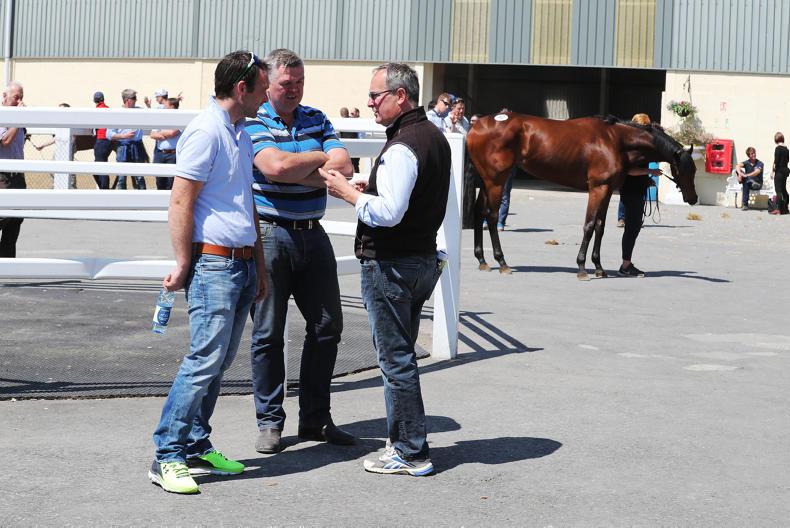

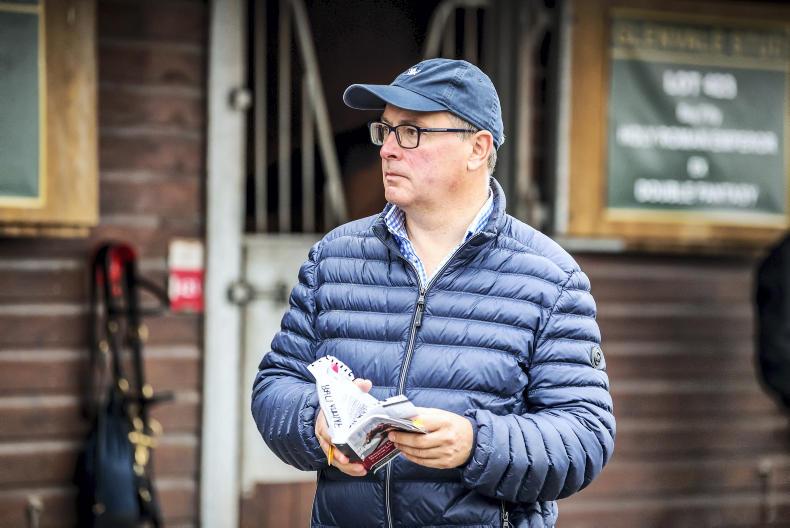
SHARING OPTIONS